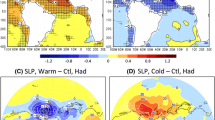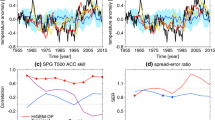Abstract
The Southern Hemisphere westerly winds are an important component of the climate system at hemispheric and global scales. Variations in their intensity and latitudinal position through an ice-age cycle have been proposed as important drivers of global climate change due to their influence on deep-ocean circulation and changes in atmospheric CO2. The position, intensity, and associated climatology of the southern westerlies during the last glacial maximum (LGM), however, is still poorly understood from empirical and modelling standpoints. Here we analyse the behaviour of the southern westerlies during the LGM using four coupled ocean-atmosphere simulations carried out by the Palaeoclimate Modelling Intercomparison Project Phase 2 (PMIP2). We analysed the atmospheric circulation by direct inspection of the winds and by using a cyclone tracking software to indicate storm tracks. The models suggest that changes were most significant during winter and over the Pacific ocean. For this season and region, three out four models indicate decreased wind intensities at the near surface as well as in the upper troposphere. Although the LGM atmosphere is colder and the equator to pole surface temperature gradient generally increases, the tropospheric temperature gradients actually decrease, explaining the weaker circulation. We evaluated the atmospheric influence on the Southern Ocean by examining the effect of wind stress on the Ekman pumping. Again, three of the models indicate decreased upwelling in a latitudinal band over the Southern Ocean. All models indicate a drier LGM than at present with a clear decrease in precipitation south of 40°S over the oceans. We identify important differences in precipitation anomalies over the land masses at regional scale, including a drier climate over New Zealand and wetter over NW Patagonia.
















Similar content being viewed by others
References
Alloway BV, Stewart RB, Neall VE, Vucetich CG (1992) Climate of the last glaciation in New Zealand, based on aerosolic quartz influx in an andesitic terrain. Quat Res 38:170–179
Bengtsson L, Hodges K, Roeckner E (2006) Storm tracks and climate change. J Clim 19:3518–3543
Blunier T, Brook EJ (2001) Timing of millennial-scale climate change in Antarctica and Greenland during the last glacial period. Science 291:109–112
Braconnot P, Otto-Bliesner B, Harrison S , Joussaume S, Peterschmitt J-Y, Abe-Ouchi A, Crucifix M, Driesschaert E, Fichefet Th, Hewitt CD, Kageyama M, Kitoh A, Laine A, Loutre M-F, Marti O, Merkel U, Ramstein G, Valdes P, Weber SL, Yu Y, Zhao Y (2007) Results of PMIP2 coupled simulations of the mid-Holocene and last glacial maximum—Part 1: experiments and large-scale features. Clim Past 3:261–277
Broecker WS (1998) Paleocean circulation during the last deglaciation: a bipolar seesaw? Paleoceanography 13:119–121
CLIMAP (1981) Seasonal reconstructions of the earth's surface at the last glacial maximum. Map Chart Series MC-36. Geological Society of America, Boulder, CO
Collins WD, Bitz CM, Blackmon ML, Bonan GB, Bretherton CS, Carton JA, Chang P, Doney SC, Hack JJ, Henderson TB, Kiehl JT, Large WG, McKenna DS, Santer BD, Smith RD (2006) The community climate system model Version 3 (CCSM3). J Clim 19:2122–2143
Denton GH, Lowell TV, Moreno PI, Andersen BG, Schlücher C (1999) Interhemispheric linkage of palaeoclimate during the last glaciation. Geogr Ann Ser A Phys Geogr 81A:107–153
Douglass DC, Singer BS, Kaplan MR, Ackert RP, Mickelson DM, Caffee MW (2005) Evidence of early Holocene glacial advances in southern South America from cosmogenic surface-exposure dating. Geology 33:237–240
Garreaud R (2007) Precipitation and circulation covariability in the extratropics. J Clim 20:4789–4797
Heusser CJ (1989) Southern westerlies during the last glacial maximum. Quat Res 31:423–425
Heusser CJ, Heusser LE, Lowell TV (1999) Paleoecology of the southern Chilean Lake District–Isla Grande de Chiloe during middle–late Llanquihue glaciation and deglaciation. Geogr Ann Ser A Phys Geogr 81:231–284
Hewitt CD, Stouffer RJ, Broccoli AJ, Mitchell JFB, Valdes PJ (2003) The effect of ocean dynamics in a coupled GCM simulation of the last glacial maximum. Clim Dyn 20:203–218. doi: 10.1007/s00382-002-0272-6
Imbrie J, Boyle EA, Clemens SC, Duffy A, Howard WR, Kukla G, Kutzbach J, Martinson DG, McIntyre A, Mix AC, Molfino B, Morley JJ, Peterson LC, Pisias NG, Prell WL, Raymo ME, Schackleton NJ, Toggweiler JR (1992) On the structure and origin of major glaciation cycles 1. Linear responses to Milankovitch forcing. Paleoceanography 7:701–738
Inatsu M, Hoskins BJ (2004) The zonal asymmetry of the Southern Hemisphere winter storm track. J Clim 17:4882–4892
Joussaume S, Taylor KE, Braconnot P, Mitchell JFB, Kutzbach JE, Harrison SP, Prentice IC, Broccoli AJ, Abe-Ouchi A, Bartlein PJ, Bonfils C, Dong B, Guiot J, Herterich K, Hewitt CD, Jolly D, Kim JW, Kislov A, Kitoh A, Loutre MF, Masson V, McAvaney B, McFarlane N, de Noblet N, Peltier WR, Peterschmitt JY, Pollard D, Rind D, Royer JF, Schlesinger ME, Syktus J, Thompson S, Valdes P, Vettoretti G, Webb RS, Wyputta U (1999) Monsoon changes for 6000 years ago: results of 18 simulations from the Palaeoclimate Modeling Intercomparison Project (PMIP). Geophys Res Lett 26:859–862
Kageyama M, Valdes P, Ramstein G, Hewitt C, Wyputta U (1999) Northern Hemisphere storm tracks in present day and Last Glacial Maximum climate simulations: a comparison of the European PMIP models. J Clim 12:742–760
Kalnay E, Coauthors (1996) The NCEP/NCAR 40-Year reanalysis project. Bull Am Meteor Soc 77:437–471
Kim SJ, Flato GM, Boer GJ (2003) A coupled climate simulation of the Last Glacial Maximum, Part2: approach to equilibrium. Clim Dyn 20:635–661
Kitoh A, Murakami S, Kiode H (2001) A simulation of the last glacial maximum with a coupled atmosphere–ocean GCM. Geophys Res Lett 28:2221–2224
Lamy F, Hebbeln D, Wefer G (1998) Late quaternary precessional cycles of terrigenous sediment input off the Norte Chico, Chile (27.5 degrees S) and palaeoclimatic implications. Palaeogeogr Palaeoclimatol Palaeoecol 140:233–244
Lamy F, Hebbeln D, Wefer G (1999) High-resolution marine record of climatic change in mid-latitude Chile during the last 28,000 years based on terrigenous sediment parameters. Quat Research 51:83–93
Levitus S (1994) NOAA Atlas NESDIS, World Ocean Atlas, U.S. Govt. Printing Office
Moreno PI (1997) Vegetation and climate change near Lago Llanquihue in the Chilean Lake District between 20,200 and 9500 14C yr B.P. J Quat Sci 12:434–441
Moreno PI, Leon A (2003) Abrupt vegetation changes during the last glacial to Holocene transition in mid-latitude South America. J Quat Sci 18:787–800
Moreno PI, Jacobson GL, Andersen B, Lowell TV, Denton GH (1999) Abrupt vegetation and climate changes during the last glacial maximum and the last Termination in the Chilean Lake District: A case study from Canal de la Puntilla (41ºS). Geografiska Annaler Series A-Physical Geography 81A:285–311
Moreno PI, Jacobson GL, Lowell TV, Denton GH (2001) Interhemispheric climate links revealed from a late-glacial cool episode in southern Chile. Nature 409:804–808
Otto-Bliesner B, Brady E, Clauzet G, Thomas R, Levis S, Kothavala Z (2006) Last glacial maximum and Holocene climate in CCSM3. J Clim 19:2526–2544
Peltier WR (1994) Ice age paleotopography. Sci 265:195–201
Peltier WR (2004) Global glacial isostasy and the surface of the ice-age Earth: the ICE-5G (VM2) model and GRACE. Ann Rev Earth Planet Sci 32:111-149
Reynolds RW, Smith TM (1994) Improved global sea surface temperature analyses using optimum interpolation. J Clim 7:929-948
Schaefer JM, Denton GH, Barrell DJA, Ivy-Ochs S, Kubik PW, Andersen BG, Phillips FM, Lowell TV, Schluchter C (2006) Near-synchronous interhemispheric termination of the last glacial maximum in mid-latitudes. Science 312:1510–1513
Shin SI, Lui Z, Otto-Bliesner B, Brady EC, Kutzback JE, Harrison SP (2003) A simulation of the last glacial maximum climate using the NCAR-CCSM. Clim Dyn 20:127-151. doi:10.1007/s00382-002-0260-x
Shulmeister J, Goodwin I, Renwick J, Harle K, Armand L, McGlone MS, Cook E, Dodson J, Hesse PP, Mayewski P, Curran M (2004) The Southern Hemisphere westerlies in the Australasian sector over the last glacial cycle: a synthesis. Quat Int 118–119:23–53
Sigman DM, Boyle EA (2000) Glacial/interglacial variations in atmospheric carbon dioxide. Nature 407:859–865
Simmonds I, Keay K (2000) Mean Southern Hemisphere extratropical cyclone behaviour in the 40-year NCEP-NCAR reanalysis. J Clim 13:973–885
Simmonds I, Murray RJ (1999) Southern extratropical cyclone behaviour in ECMWF analysis during the FROST Special Observing Periods. Wea Forecasting 14:878–891
Simmonds I, Murray RJ, Leighton RM (1999) A refinement of cyclone tracking methods with data from FROST. Aust Meteor Antarctic Mag Special Issue, pp 35–49
Stenni B, Masson-Delmotte V, Johnson S, Jouzel J, Longinelli A, Monnin E, Rothlisberger R, Selmo E (2001) An oceanic cold reversal during the last deglaciation. Science 293:2074–2077
Sugden DE, Bentley MJ, Fogwill CJ, Hulton NRJ, Mcculloch RD, Purves RS (2005) Late-glacial glacier events in Southernmost South America: A blend of ‘Northern’ and ’Southern’ Hemispheric climate signals? Geogr Anna Ser A Phys Geogr 87:273–288
Toggweiler JR, Russel J, Carson SR (2006) Midlatitude westerlies, atmospheric CO2, and climate change during the ice ages. Paleooceonography 21:PA2005. doi:10.1029/2005PA001154
Turney CSM, Gaberle S, Fink D, Kershaw AP, Barbetti M, Barrows TT, Black M, Cohen TJ, Correge T, Hesse PP, Hua Q, Johnston R, Morgan V, Moss P, Nanson G, Van Ommen T, Rule S, Williams NJ, Zhao J-X, D’Costa D, Feng Y-X, Gagan M, Mooney S, Xia Q (2006) Integration of ice-core, marine and terrestrial records for the Australian last glacial maximum and termination: a contribution from the OZINTIMATE group. J Quat Sci 21(7):751–761
Valdes PJ (2000) South American paleoclimate model simulations: how reliable are the models? J Quat Sci 15:357–368
Valero-Garcés BL, Jenny B, Rondanelli M, Delgado-Huertas A, Burns SJ, Veit H, Moreno A (2005) Palaeohydrology of Laguna de Tagua Tagua (34° 30'S) and moisture fluctuations in Central Chile for the last 46 000 yr. J Quat Sci 20:625–641
Williams GP, Bryan K (2006) Ice age winds: an aquaplanet model. J Clim 19:1706–1715
Williams PW, Kingb DNT, Zhaoc J-X, Collerson KD (2005) Late Pleistocene to Holocene composite speleothem 18O and 13C chronologies from South Island, New Zealand-did a global Younger Dryas really exist? Earth Planet Sci Lett 230:301–317
Wyrwoll K-H, Dong B, Valdes P (2000) On the position of southern westerlies at the last glacial maximum: an outline of AGCM simulation results and evaluation of their implications. Quat Sci Rev 19:881–898
Xie P, Arkin PA (1996) Analyses of global monthly precipitation using gauge observations, satellite estimates, and numerical model predictions. J Clim 9:840–858
Yin JH (2005) A consistent poleward shift of the storm tracks in simulations of 21st century climate. Geophys Res Lett 32:L18701. doi:10.1029/2005GL023684
Acknowledgments
We acknowledge the international modelling groups for providing their data for analysis, the Laboratoire des Sciences du Climat et de l’Environnement (LSCE) for collecting and archiving the model data. The PMIP2/MOTIF Data Archive is supported by CEA, CNRS, the EU project MOTIF (EVK2-CT-2002-00153) and the Programme National d’Etude de la Dynamique du Climat (PNEDC). The analyses were performed using version mm-dd-yyyy of the database. More information is available on http://pmip2.lsce.ipsl.fr/ and http://motif.lsce.ipsl.fr. This investigation was supported by the FONDECYT grant # 1050416 and Institute of Ecology and Biodiversity, IEB. M. Rojas also thanks the ACT19 project. Disussion with Aldo Montecino on the ocean analysis and comments of two anonymous reviewers contributed greatly to the final version of the paper.
Author information
Authors and Affiliations
Corresponding author
Rights and permissions
About this article
Cite this article
Rojas, M., Moreno, P., Kageyama, M. et al. The Southern Westerlies during the last glacial maximum in PMIP2 simulations. Clim Dyn 32, 525–548 (2009). https://doi.org/10.1007/s00382-008-0421-7
Received:
Accepted:
Published:
Issue Date:
DOI: https://doi.org/10.1007/s00382-008-0421-7




